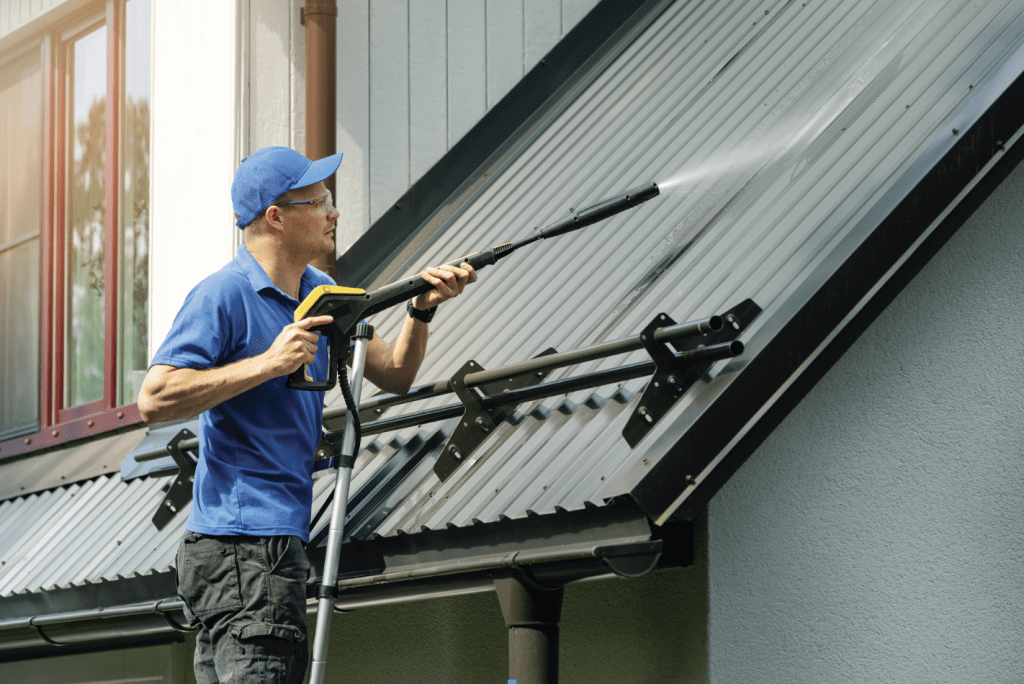Maintaining the cleanliness and appearance of a metal roof is crucial for its longevity and performance. When it comes to cleaning, many homeowners wonder if pressure washing is a suitable method for metal roofs. In this article, we will explore whether you can pressure wash a metal roof, discussing the pros, cons, and best practices to ensure safe and effective cleaning.

The Pros of Pressure Washing a Metal Roof:
Pressure washing can offer several benefits when cleaning a metal roof:
- Effective Cleaning: Pressure washing can remove dirt, debris, algae, moss, and other stubborn stains effectively. The high-pressure water stream can help restore the metal roof’s original shine and appearance.
- Time-Saving: Compared to manual cleaning methods, pressure washing can save time and effort. The powerful spray can cover a larger surface area, making the cleaning process more efficient.
- Accessibility: Pressure washing allows you to clean hard-to-reach areas, such as roof valleys and high peaks, without the need for climbing or using ladders extensively.
The Cons of Pressure Washing a Metal Roof:
While pressure washing can be effective, it also comes with potential drawbacks:
- Potential Damage: If not done properly, pressure washing can cause damage to the metal roof. Excessive pressure, incorrect nozzle selection, or improper technique can lead to denting, scratching, or dislodging of the metal panels.
- Water Intrusion: Pressure washing can force water under the metal roof panels, potentially causing leaks and water damage to the underlying structure. This is especially true if the roof has existing vulnerabilities, such as loose fasteners or deteriorated seals.
- Voiding Warranty: Some metal roof manufacturers may void the warranty if pressure washing is used as a cleaning method. It is important to check the manufacturer’s guidelines and warranty terms before deciding to pressure wash the roof.
Best Practices for Pressure Washing a Metal Roof:
If you decide to pressure wash your metal roof, follow these best practices to ensure a safe and effective cleaning process:
- Use Low Pressure: Set the pressure washer to a low setting, typically between 500 to 1200 PSI (pounds per square inch). Avoid using high-pressure settings to minimize the risk of damaging the metal roof.
- Choose the Right Nozzle: Select a wide-angle or fan spray nozzle instead of a pinpoint nozzle. This will distribute the water over a larger area and reduce the intensity of the spray.
- Maintain a Safe Distance: Keep a safe distance between the pressure washer nozzle and the metal roof, typically around 2 feet. This distance helps prevent damage and allows the water to clean effectively.
- Test in a Small Area: Before starting the full cleaning process, test the pressure washer in a small, inconspicuous area to ensure it does not cause any damage or water intrusion.
- Clean from Top to Bottom: Begin cleaning at the top of the roof and work your way down. This prevents dirt and debris from washing onto already cleaned areas.
- Protect Surrounding Areas: Cover plants, windows, and any other sensitive areas near the roof to protect them from the cleaning solution and water runoff.
Conclusion:
While pressure washing can be an effective method for cleaning a metal roof, it comes with potential risks. It is important to consider the pros and cons before deciding to pressure wash your metal roof. If you choose to proceed, follow the best practices mentioned above to minimize the risk of damage and water intrusion. Alternatively, consider consulting a professional roofing contractor who can provide expert advice and offer safe and efficient cleaning solutions for your metal roof.



Leave a Reply